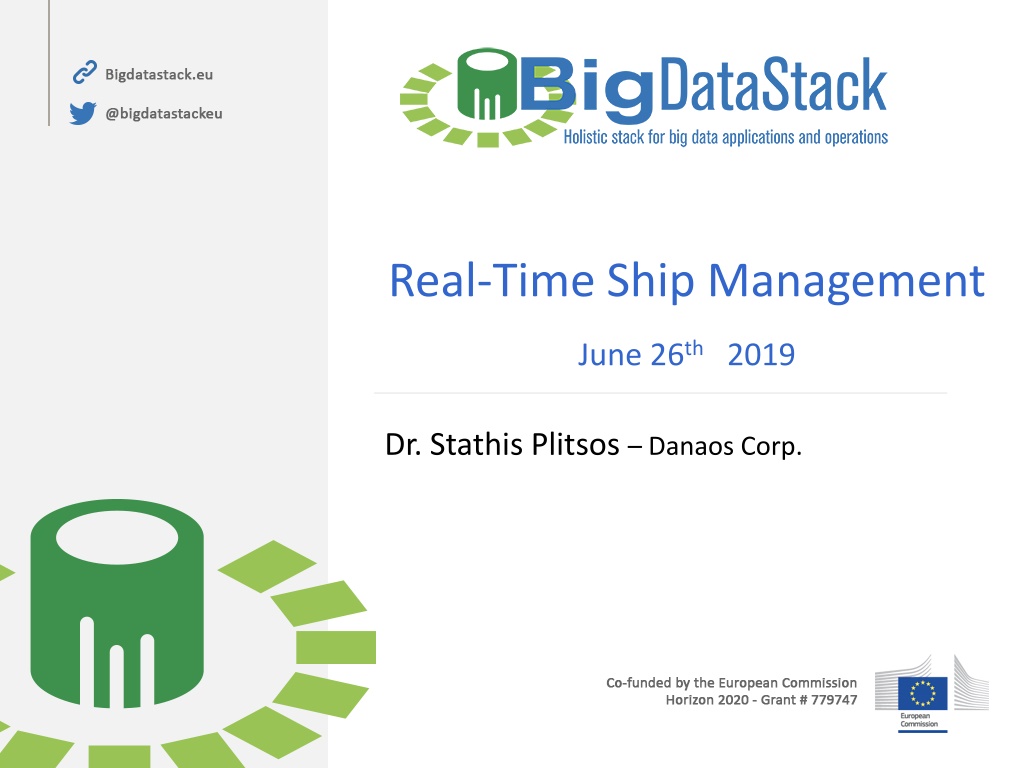
Real-Time Ship Management for Maritime Efficiency
Explore the challenges and strategies in real-time ship management to ensure operational efficiency and prevent unexpected failures in vessel operations. Learn how Danaos Corp. leverages data and technology to optimize ship performance and maintenance protocols.
Download Presentation

Please find below an Image/Link to download the presentation.
The content on the website is provided AS IS for your information and personal use only. It may not be sold, licensed, or shared on other websites without obtaining consent from the author. Download presentation by click this link. If you encounter any issues during the download, it is possible that the publisher has removed the file from their server.
E N D
Presentation Transcript
Real-Time Ship Management June 26th2019 Dr. Stathis Plitsos Danaos Corp.
About Danaos Shipping Leading international maritime player; One of the biggest ship-owning companies; 60 containerships; Transports millions of containers; Sails millions of miles to thousands of ports; Consumes millions of tons of fuel oil. 2 Real-Time Ship Management 16.07.2019
Storyboard - scenario (1/5) A vessel has to complete its route within a time- frame; If a main engine part fails unexpectedly, the ship risks going off-hire; This can be very damaging to a shipping company: Chartering revenues decrease; Bad company-image; Replacing a spare part immediately increases cost. Identification of potential failures allows: Timely ordering of spare parts; Replacement of parts before failure. 3 Real-Time Ship Management 16.07.2019
Storyboard - scenario (2/5) Discussing about malfunctions in general in a vessel s engine room is a joke; We focus on a specific malfunction of the main engine which: Is not a sudden event. It evolves gradually; Can be detected only with an on-board inspection; Has not (yet) a known correlation of metrics that could pinpoint it, so looking over the data is not helpful; Occurs on cross-head bearings. We know the main cause; Slow steaming leads to bad lubrication of the cyllinder components; We wish to identify it early on; The wear of this bearing as a physical phenomenon should be somehow hidden in the data. 4 Real-Time Ship Management 16.07.2019
Storyboard - scenario (3/5) 5 06-08.02.2018
Storyboard - scenario (4/5) Technical Challenges: The main engine, posing the highest risk, consists of various spare parts depending on many parameters; It is difficult to accurately predict failures; Data loss may occur (~broken sensors on-board); Malfunction pattern identification seems to be data intensive and computationally demanding. 6 06-08.02.2018
Storyboard - scenario (5/5) Operational Challenges If false alarms occurs, The operating costs increase; Ordering of unnecessary parts is not optimal; The multivariate nature of the supply department makes the selection of the port challenging; The price depends on: The port; The time-frame of order; The required personnel replacing this part. 7 06-08.02.2018
Data to be used Operational data, i.e., telegrams (38K records): Every 12 hours or upon arrival/departure; Updated when an error is identified, i.e., rarely. General purpose sensor data (21 different sensors, 29M records): Per-minute basis. Main engine sensor data (100 different sensors, 29M records): Per-minute basis. 8 Real-Time Ship Management 16.07.2019
BigDataStack added-value (1/2) Since the complete environment has been utilized, all components of BigDataStack are used; Functionality bringing key added-value is delivered by BigDataStack: Real-time stream processing to identify sensor malfunctions & violations of specified conditions by the distributed CEP Preventive maintenance in an efficient way considering all available datasets by the deployment configurations and the seamless analytics framework Enhanced query speed as required by the specific performance constraint by the data skipping technology of BigDataStack 9 Real-Time Ship Management 16.07.2019
BigDataStack added-value (2/2) Functionality bringing key added-value is delivered by BigDataStack (cont): Ensure that predictions are based on data of specific quality through sensors malfunctions identification and data quality assessment delivered by BigDataStack components High level of flexibility to ingest / integrate new algorithms without dealing with the underlying storage mapping and utilization through the BigDataStack data toolkit Seamless and of high performance extension of the approach to additional vessels and / or additional data streams through automated provision and management of infrastructure resources by BigDataStack 10 Real-Time Ship Management 16.07.2019
